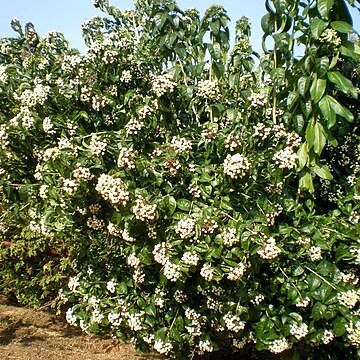A shrub 1-4 m tall or a small tree up to 6.5 m. Stems erect, cylindrical, brown when young eventually grey; branches straight, somewhat thick, lenticellate, glabrous or finely imperceptibly puberulous, leaf scars ± raised with tomentellous buds in the axils. Leaves opposite or 3-whorled; lamina 5-10 x 0.8-5.5 cm, elliptic to elliptic-ovate or ovate, obtuse or acute or sometimes attenuate to a very acute apex, cuneate or rounded at the base, entire with slightly revolute margins, ± fleshy, drying ± coriaceous and somewhat wrinkled, very densely punctate, foetid, sometimes folded along the midrib, rather caducous; petiole 1-2 cm long, slender, ascending or spreading. Inflorescences terminal, corymbose, subspherical, loose to ± dense, 3-14 cm in diameter, sometimes surrounded and exceeded by the uppermost leaves; smaller inflorescences in the axils of the upper leaves sometimes also present; axes, pedicels and bracts ± puberulous; pedicels 0.75-6 mm long; bracts and bracteoles linear, 1.5-2.5 mm long, ± equalling the calyx. Calyx campanulate, 2.5-3.5 mm long; tube 2.5-3 mm in diameter, glabrescent to ± densely pubescent with ± appressed, whitish hairs; lobes (0.5)0.75-1.5(3) mm long, triangular and narrowing to the apex but not linear, separated by rounded sinuses. Corolla usually white, sometimes mauve or white suffused with mauve, cream or greenish, sweet-scented; tube (4)4.5-8(10) mm long, slender, only with sessile glands or rarely also sparsely hairy above; lobes 2.5-4 x 2 mm. Stamens mauve or lilac, exserted 5-7 mm; anthers 1-1.25 mm long, violet or brown. Fruits marbled-white, but black when dry, 6-10 mm in diameter, strongly wrinkled and ± lobed when dry, sitting in a ribbed shallow, lobed fruiting calyx 8 mm wide; edible.
More
Perennial shrub or small tree, 0.3-9.0 m high; stems erect, cylindrical; branches straight, lenticellate, glabrous or puberulous. Leaves opposite or 3-whorled, elliptic to ovate, base cuneate or rounded, apex obtuse or acute or sometimes attenuate, margins entire or slightly revolute. Inflorescences terminal, corymbose, subspherical; axes, pedicels and bracts puberulous; bracts and bracteoles linear. Flowers white, mauve, pinkish or creamy white. Calyx campanulate, glabrescent to densely pubescent, hairs appressed; lobes triangular. Corolla: tube sparsely pubescent; lobes oblong. Style and stamens exserted. Flowering time Oct.-Mar. Fruit strongly wrinkled, edible.
A shrub or small tree. It can be 10 m tall. It is much branched. The flowers have a scent. The fruit are 6-10 mm across. They are yellowish-white.


